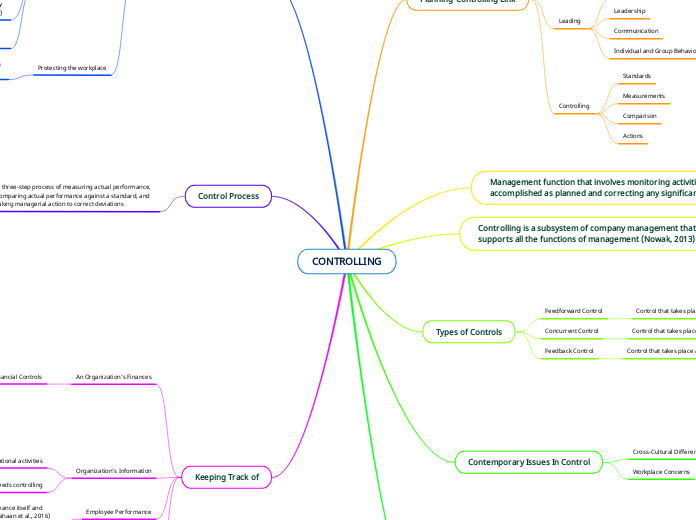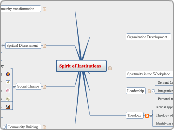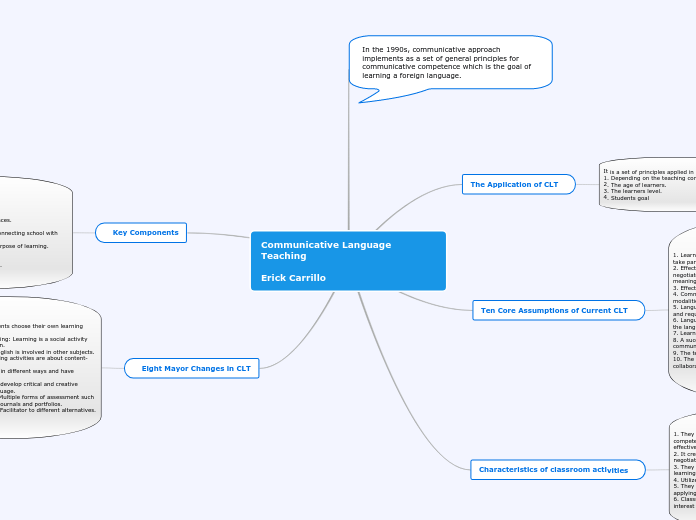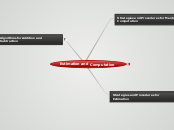CONTROLLING
Keeping Track of
Using a Balanced Scorecard Approach
By typically looking at FOUR areas
People/innovation/growth assets
Internal processes
Customer
Financial
A performance measurement tool that looks at more than just the financial perspective
Employee Performance
Is needed to achieve employee performance itself and also for the success of the company (Siahaan et al., 2016)
Organization's Information
An organizational resource that needs controlling
A critical tool for controlling other organizational activities
Management Information System (MIS)
A system used to provide management with needed information on a regular basis
An Organization's Finances
Traditional Financial Controls
Budget Analysis
Controlling Tool
Planning Tool
Ratio Analysis
Profitability Ratios
Activity Ratios
Leverage Ratios
Liquidity Ratios
Control Process
A three-step process of measuring actual performance, comparing actual performance against a standard, and taking managerial action to correct deviations
Correct Actual Performance
Basic Corrective Action
Corrective action that looks at how and why performance deviated before correcting the source of deviation
Immediate Corrective Action
Corrective action that addresses problems at once to get performance back on track
Depending on what the problem is, a manager could take different corrective actions
Compare
Range of Variation
The acceptable parameters of variance between actual performance and a standard
Determines the variation between actual performance and the standard
Measuring
Management by walking around (MBWA)
When a manager is out in the work area interacting with employees
To determine actual performance
Value of the control function
Protecting the workplace
Comprehensive controls and backup plans will help minimize work disruptions.
Empowering employees
Huxtable (1994) asserts that employee empowerment is giving authority to employees to deal with daily job activities.
Empowerment gives an employee the authority to make decisions (Said & Saleh, 2013), thus, they can be motivated, committed, satisfied and help in dealing with customer needs (Jacquiline, 2014)
Employee empowerment focuses on developing trust, motivation, and participating in decision-making (Meyerson & Dewettinck, 2012)
According to Randolph (1995) employee empowerment is the "transfer of power" from the employer to the employees.
An effective control system can provide information and feedback on employee performance and minimize the chance of potential problems.
To ensure that what employees are supposed to do is, in fact, being done and goals are being achieved.
Control Challenges In The Workplace
Workplace Violence
Employee Theft
According to Omar et al. (2011) and Weber, Kurke, and Pentico (2003), employee theft affects approximately 95% of all busineese and costs them billions of dollars each year.
Any unauthorized taking of company property by employees for their personal use
Employees' Computer Usage
Contemporary Issues In Control
Workplace Concerns
Cross-Cultural Differences
Types of Controls
Feedback Control
Control that takes place after a work activity is done
Concurrent Control
Control that takes place while a work activity is in progress
Feedforward Control
Control that takes place before a work activity is done
Controlling is a subsystem of company management that supports all the functions of management (Nowak, 2013)
Management function that involves monitoring activities to ensure that they're being accomplished as planned and correcting any significant deviations
Planning-Controlling Link
Controlling
Actions
Comparison
Measurements
Standards
Leading
Individual and Group Behavior
Communication
Leadership
Motivation
Organizing
Human Resource Management
Structure
Planning
Plans
Strategies
Objectives
Goals









